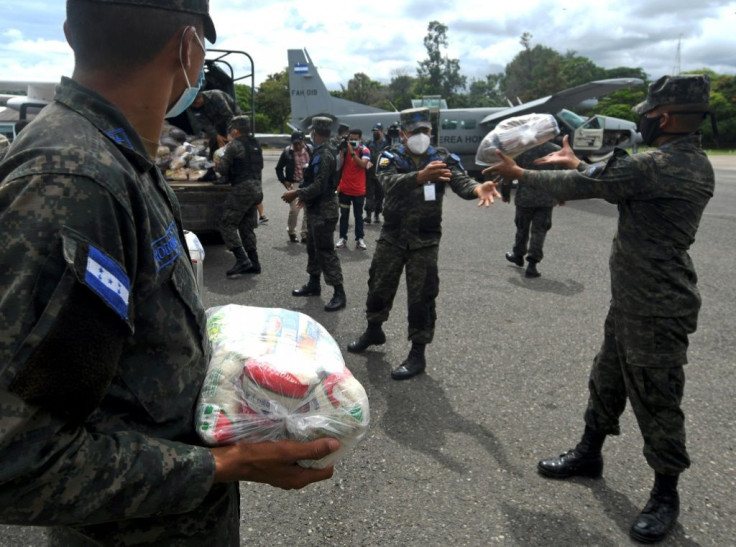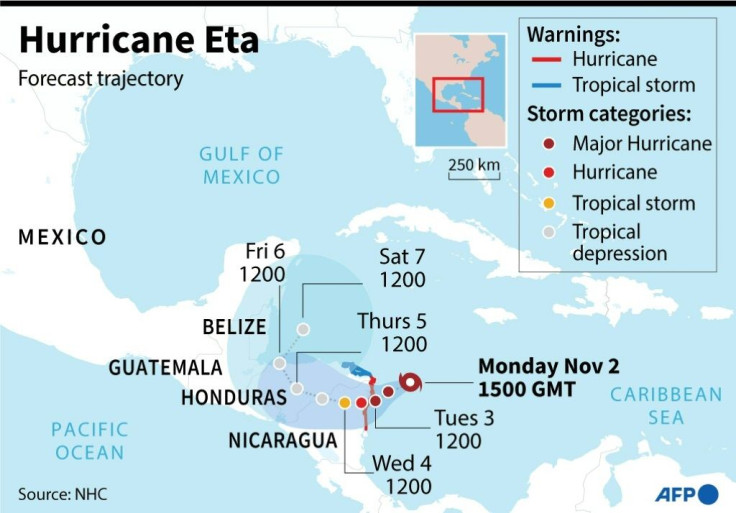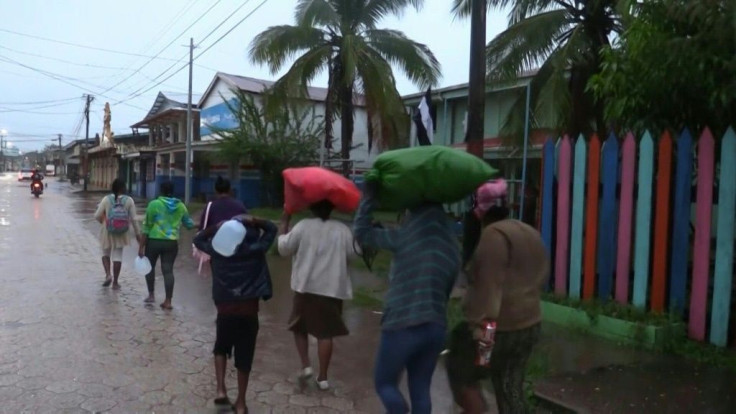'Extremely Dangerous' Hurricane Eta Hits Nicaragua
An "extremely dangerous" hurricane named Eta lashed the north coast of Nicaragua on Tuesday as it made landfall packing heavy rain and high winds, authorities said.
"It was a Category 4 impact" on the Saffir-Simpson scale that ranges from one to five, said Marcio Baca, director of meteorology at the Nicaraguan Institute of Territorial Studies (INETER.)
"It has winds of 230 kph (140 miles per hour). It's basically at the edge of land," said Baca.
Hurricane Eta tore up trees and roofs in Bilwi, the main city on Nicaragua's Caribbean coast, subjecting its residents to a 10-hour ordeal.
"We spent the whole night with strong gusts of wind alongside rain that is still falling," Kenny Lisby, the director at Radio Caribe, told AFP. "It's possible there's been quite a lot of destruction."

Category 4 hurricanes reach between 130 and 156 mph (209-251 kph) and can cause "catastrophic damage," according to the US National Hurricane Center (NHC.)
Nicaraguan authorities said there had been no reports of deaths.
Around 100,000 people live in Bilwi region, also known as Puerto Cabezas, mostly indigenous people living in villages.
The weather system had rapidly gained strength in the Caribbean Sea on Monday.
"Life threatening storm surge, catastrophic winds, flash flooding and landslides are expected across portions of Central America," the NHC had warned.

In the North Caribbean Coast region of Nicaragua "the homes are totally vulnerable, they're old houses made of wood lined with plastic," said Kevin Gonzalez, a member of the voluntary brigades helping residents.
The government sent 88 tons of food to the region as well as health crews and teams to fix power lines and communications.
Two air force planes carrying military personnel and health care teams were also sent.
In the coastal Prinzapolka village, metal sheets were ripped off wooden houses and swirling around in the air, Kevin Lacwood, 22, a teacher from the Miskito indigenous community, told AFP.
The government said it had managed to evacuate 6,000 families to secure homes and thousands of others to shelters.

Honduras joined Nicaragua in declaring a red alert in anticipation of being hit by the hurricane, which is expected to lose power in the coming hours.
A young girl died after floods caused a house to collapse in San Pedro Sula, the second largest city in Honduras.
Emergency services had to evacuate more than 400 people due to the floods. Another 100 people were evacuated from the ports of La Ceiba and Tela.
The water level in the Lean and La Masica rivers in the Atlantida department also rose, emergency services said.
The NHC had earlier recorded winds of 150 miles (240 kilometers) an hour as they barrelled towards the Nicaraguan coast.
Tropical storm-force winds at Eta's leading edge were already slamming the outlying Miskito Cays late on Monday.
Lackwood told AFP that the community's women and children had already been evacuated from the village of 800 people.
"If the situation becomes more dangerous," Lackwood said, the men would leave too.
Another 1,600 indigenous people were evacuated from the outlying Miskitos Cays archipelago on Sunday.
"We have managed to evacuate more than 3,000 families with the active participation of our army from Caribbean communities," such as Prinzapolka and the Miskito Cays, Nicaragua's Vice President and first lady Rosario Murillo said.
Those families have been moved to shelters in high, safe areas, said Murillo.
Residents stocked up with food, lamps, radios and plastic bags to protect their belongings.
Other regions were also facing a mauling from Eta, as the NHC said that "flash flooding and river flooding would be possible across Jamaica, southeast Mexico, El Salvador, southern Haiti, and the Cayman Islands."
The NHC warned Monday that "much of Nicaragua and Honduras would get 15 to 25 inches (380 to 635 mm)" of rain.
Eta dumped heavy rains in Costa Rica on Sunday, where authorities evacuated people from the country's southern Pacific coast.
© Copyright AFP 2024. All rights reserved.




















